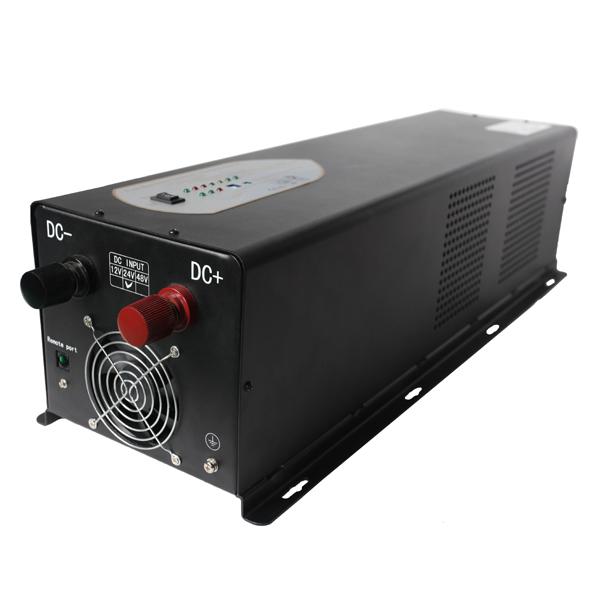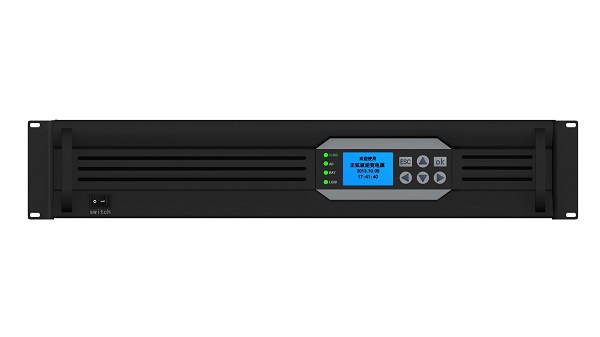The difference between industrial frequency inverter and high frequency inverter
Consumers are always entangled between industrial frequency inverters and high frequency inverters when purchasing inverters. What is the difference between the two? Which is better? You will know the answer after reading this article, so you will no longer be confused when buying an inverter.
The power frequency inverter first inverts the direct current into a power frequency low voltage alternating current; then it is boosted by a power frequency transformer into 220V, 50Hz alternating current for the load. It has the advantage of simple structure and various protection functions can be realized under lower voltage. Because there is a power frequency transformer between the inverter power supply and the load, the inverter operates stably, reliably, has strong overload capacity and impact resistance, and can suppress high-order harmonic components in the waveform. However, the power frequency transformer also has the problem of being bulky and expensive, and its efficiency is relatively low. The small power frequency inverter manufactured according to the current level generally has a rated load efficiency of not more than 90%. At the same time, the iron loss of the power frequency transformer is basically unchanged when the power frequency transformer is operated under full load and light load, so it can operate under light load. The no-load loss is larger and the efficiency is lower.
The high-frequency inverter first uses high-frequency DC/DC conversion technology to invert low-voltage direct current into high-frequency and low-voltage alternating current; then, after being boosted by a high-frequency transformer, it is rectified by a high-frequency rectifier filter circuit to usually above 300V High-voltage DC power; finally, 220V power frequency AC power is obtained through the power frequency inverter circuit for the load. Because the high-frequency inverter adopts a small-sized and light-weight high-frequency magnetic core material, the power density of the circuit is greatly increased, so that the no-load loss of the inverter power supply is small and the inverter efficiency is improved. Generally, high-frequency inverters used in small and medium-sized PVS have a peak conversion efficiency of more than 90%.
Comparing the two inverters, it can be seen that the inverter power frequency machine of the same power is much heavier than the high frequency machine. The high frequency inverter is small in size, light in weight, high in efficiency, and low in no-load load, but cannot be connected to full load. Inductive load, and poor overload capacity.
The working principle of the two circuits is different, and the circuit of the high frequency machine is more complicated. The power frequency machine and the high frequency machine are distinguished according to the design circuit operating frequency of the inverter.
The power frequency machine is designed based on the traditional analog circuit principle and consists of a thyristor (SCR) rectifier, an IGBT inverter, a bypass and a power frequency step-up isolation transformer. Because the working frequency of its rectifier and transformer is 50Hz, it is called a power frequency inverter as the name suggests.
The high frequency machine is usually composed of IGBT high frequency rectifier, battery converter, inverter and bypass. The IGBT can be turned on and off by controlling the drive added to the gate. The switching frequency of the IGBT rectifier is usually from a few kilohertz to tens of kilohertz, or even as high as hundreds of kilohertz, which is much higher than that of a power frequency machine. It is a high frequency inverter.

In the power frequency inverter circuit, the three-phase AC input of the main circuit is converted into a DC voltage after being connected to a rectifier composed of three SCR bridge arms through a commutation inductor, and the output DC voltage is adjusted by controlling the conduction angle of the rectifier bridge SCR value. Since the SCR is a semi-controlled device, the control system can only control the turn-on point. Once the SCR is turned on, even if the gate drive is removed, it cannot be turned off. It can only be turned off naturally after its current is zero, so it turns on and off All are based on a power frequency cycle, and there is no high-frequency turn-on and turn-off control. Since the SCR rectifier is a step-down rectifier, the AC voltage output by the DC bus voltage through the inverter is lower than the input AC voltage. If the output phase voltage can obtain a constant 220V voltage, a step-up isolation transformer must be added to the inverter output.

In contrast, high-frequency inverter rectification is a step-up rectification, and the output DC bus voltage is higher than the peak value of the input line voltage, and the typical value is about 800V. If the battery is directly connected to the bus, the standard battery required The number of knots requires 67 knots, which brings great limitations to practical applications. Therefore, the general high frequency inverter will be equipped with a battery voltage converter separately. When the mains is normal, the battery converter will reduce the 800V bus voltage to the battery voltage; when the mains fails or exceeds the limit, the battery converter will increase the battery voltage. Bus voltage up to 800V. Since the bus voltage of the high frequency machine is about 800V, the output phase voltage of the inverter can reach 220V directly, and the step-up transformer is no longer needed after the inverter. Therefore, the presence or absence of an isolation transformer is the main difference in structure between a power frequency machine and a high frequency machine.

